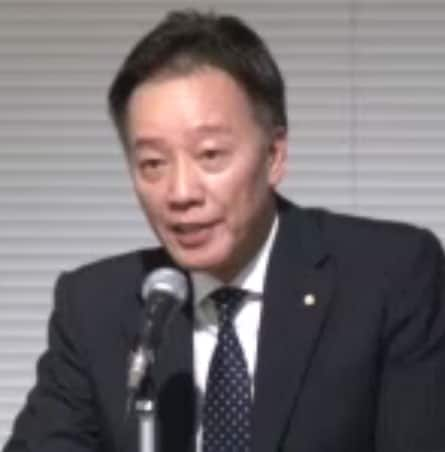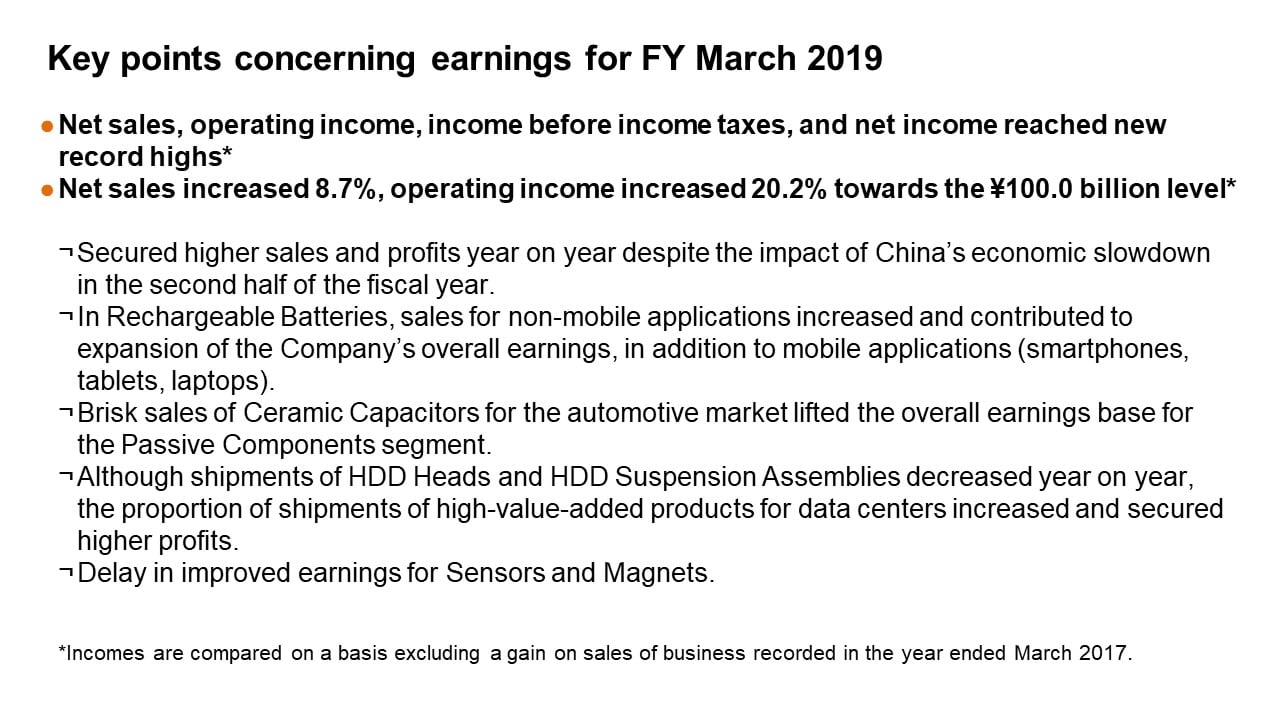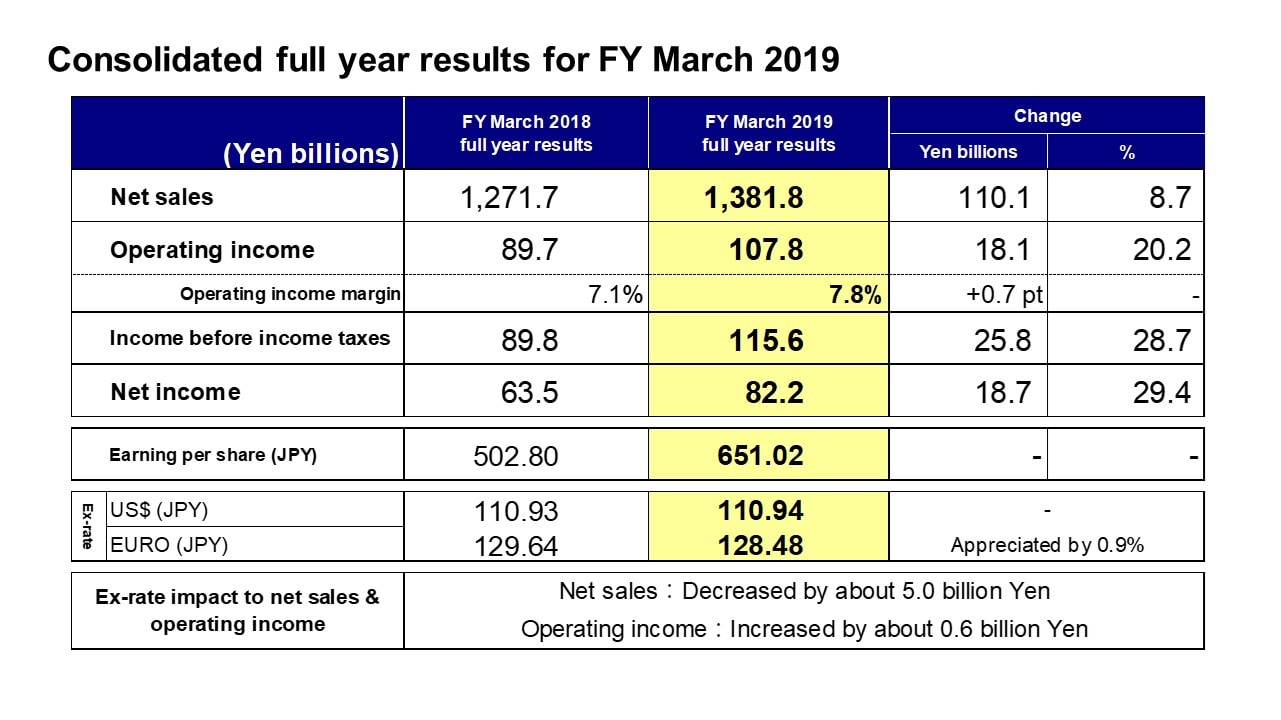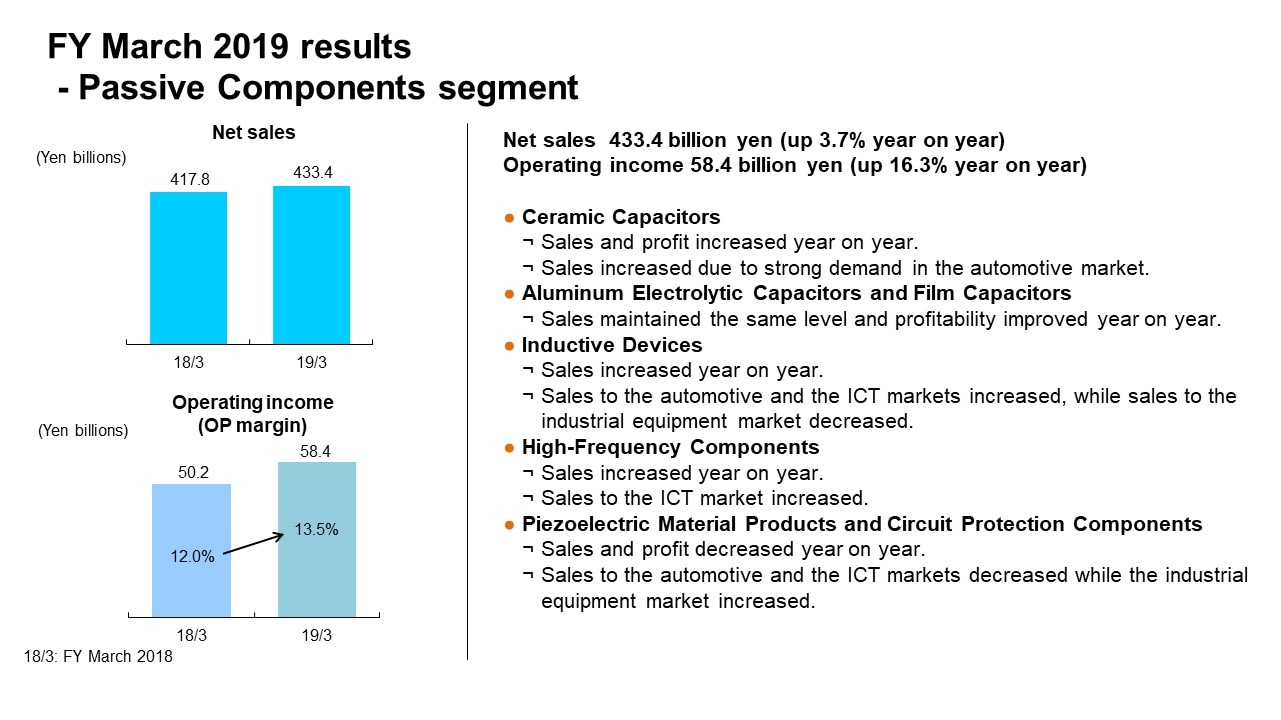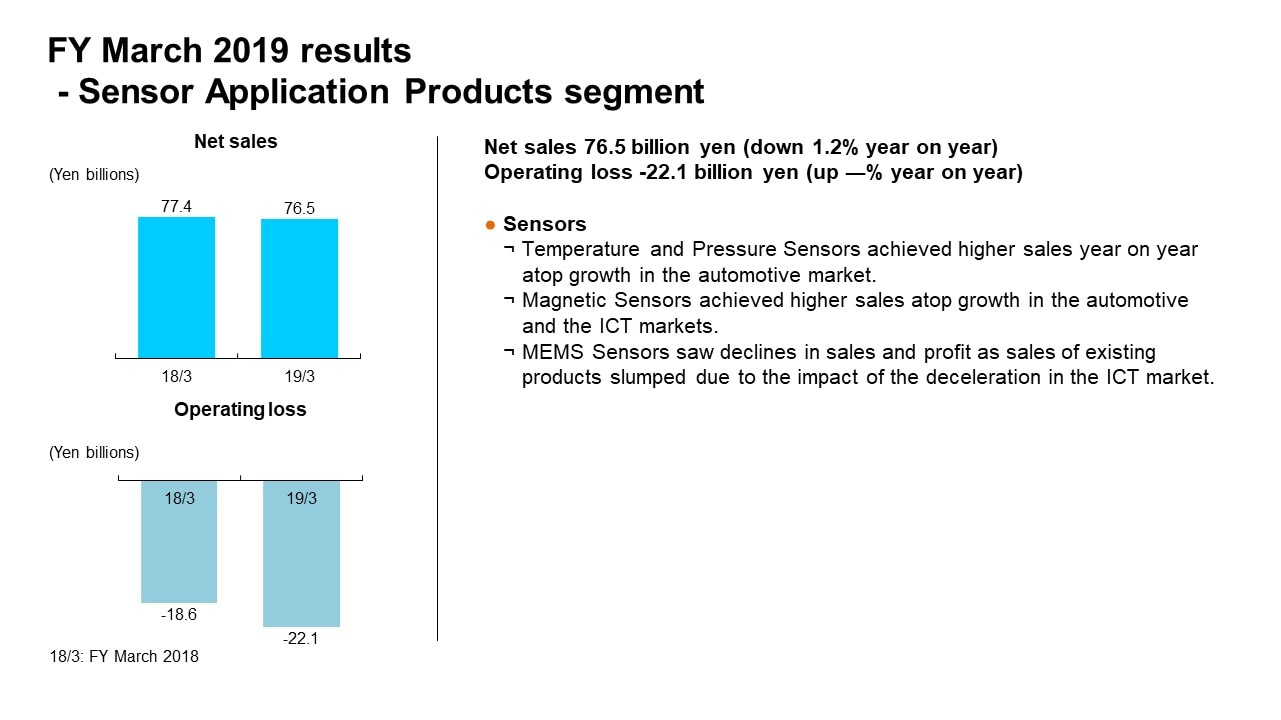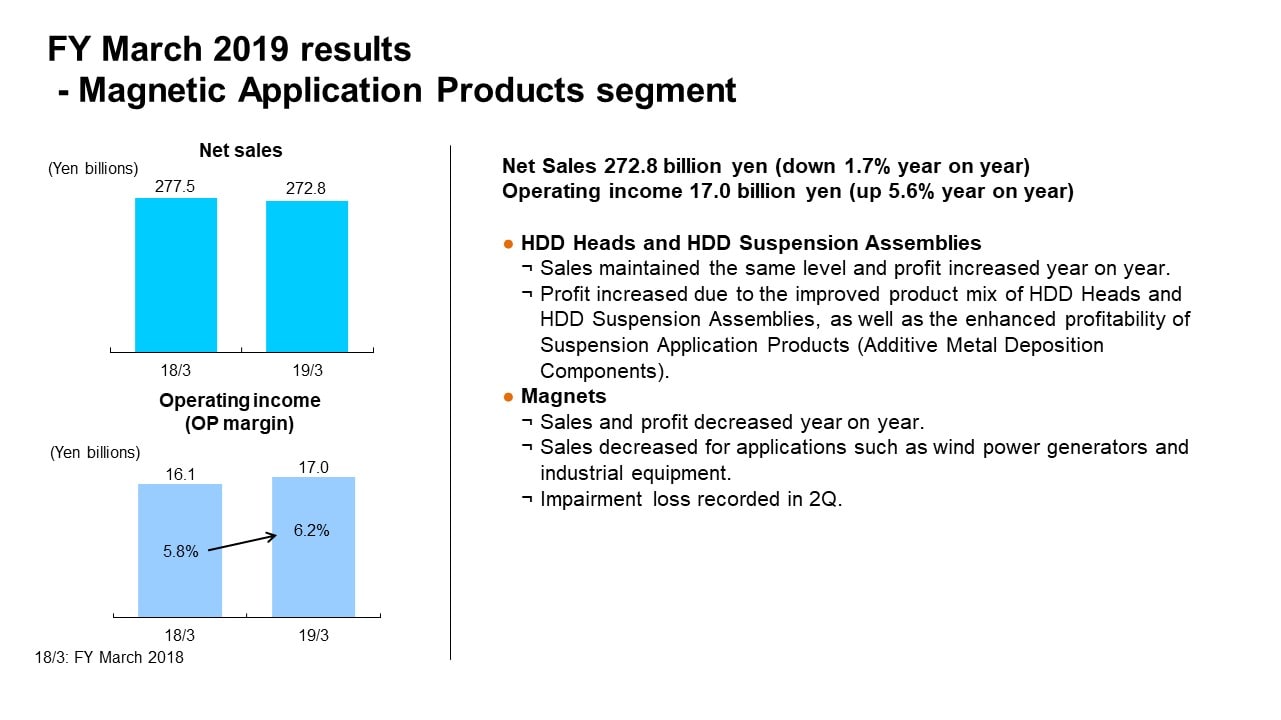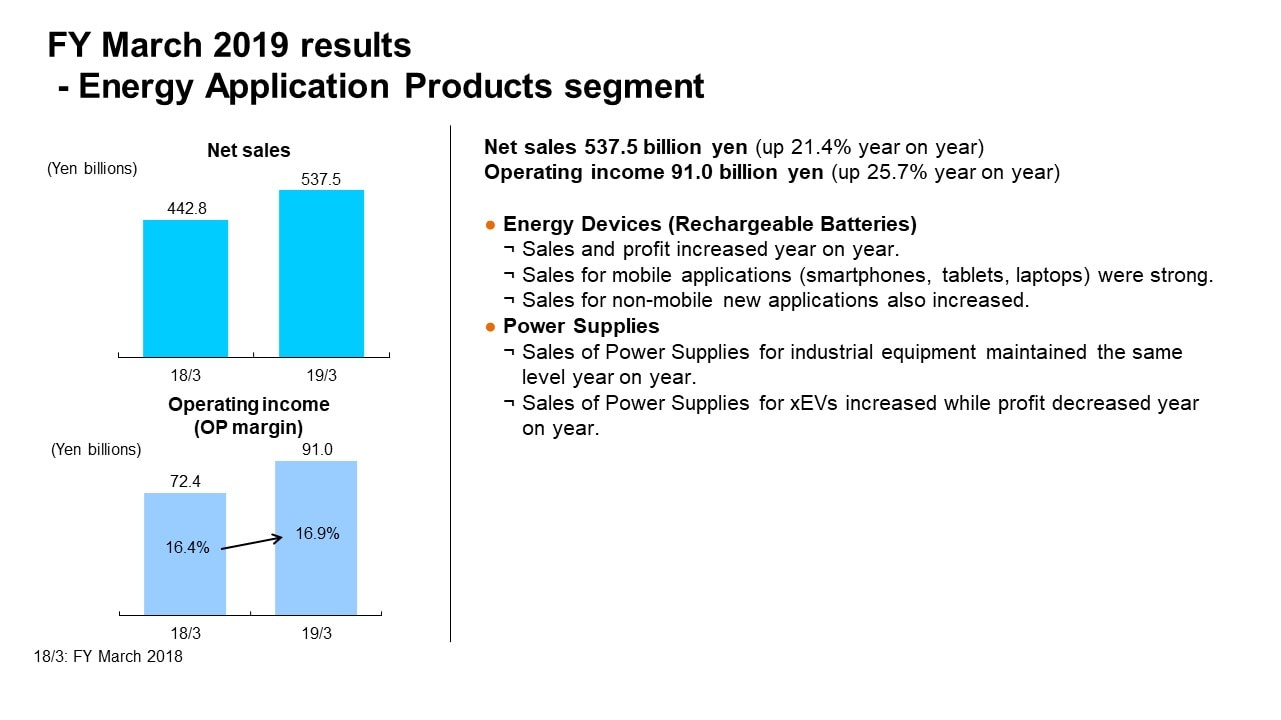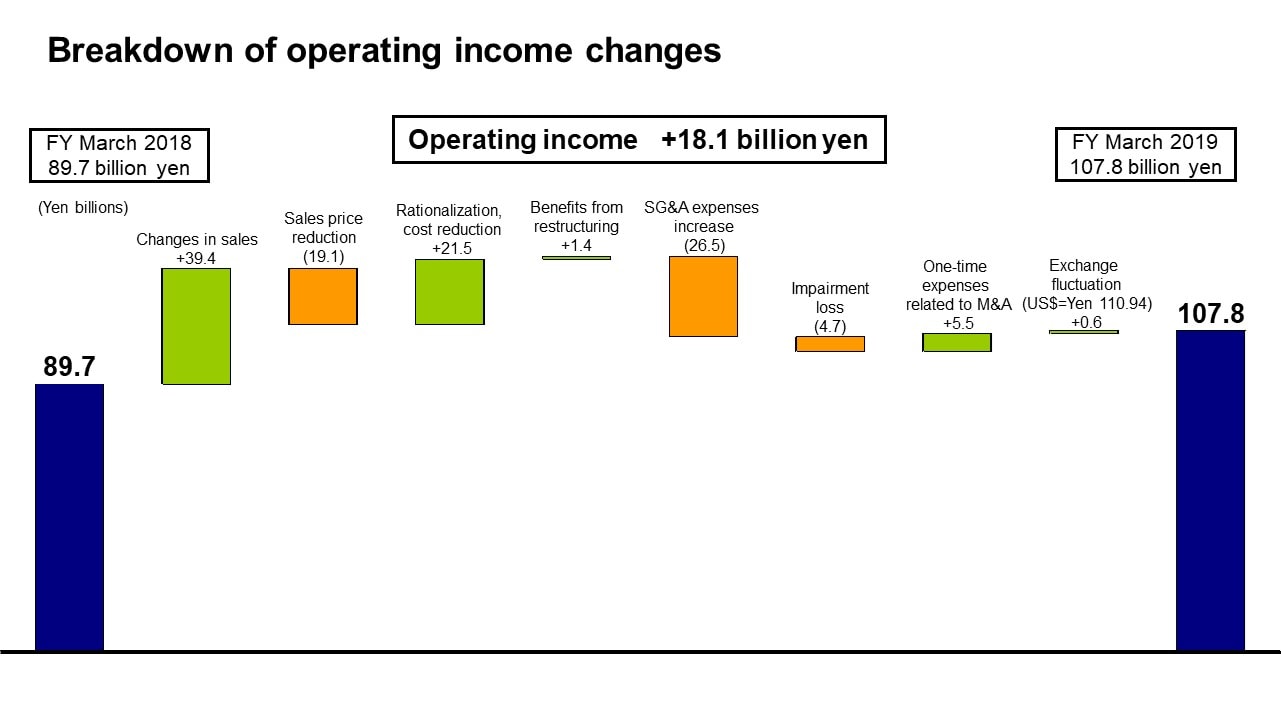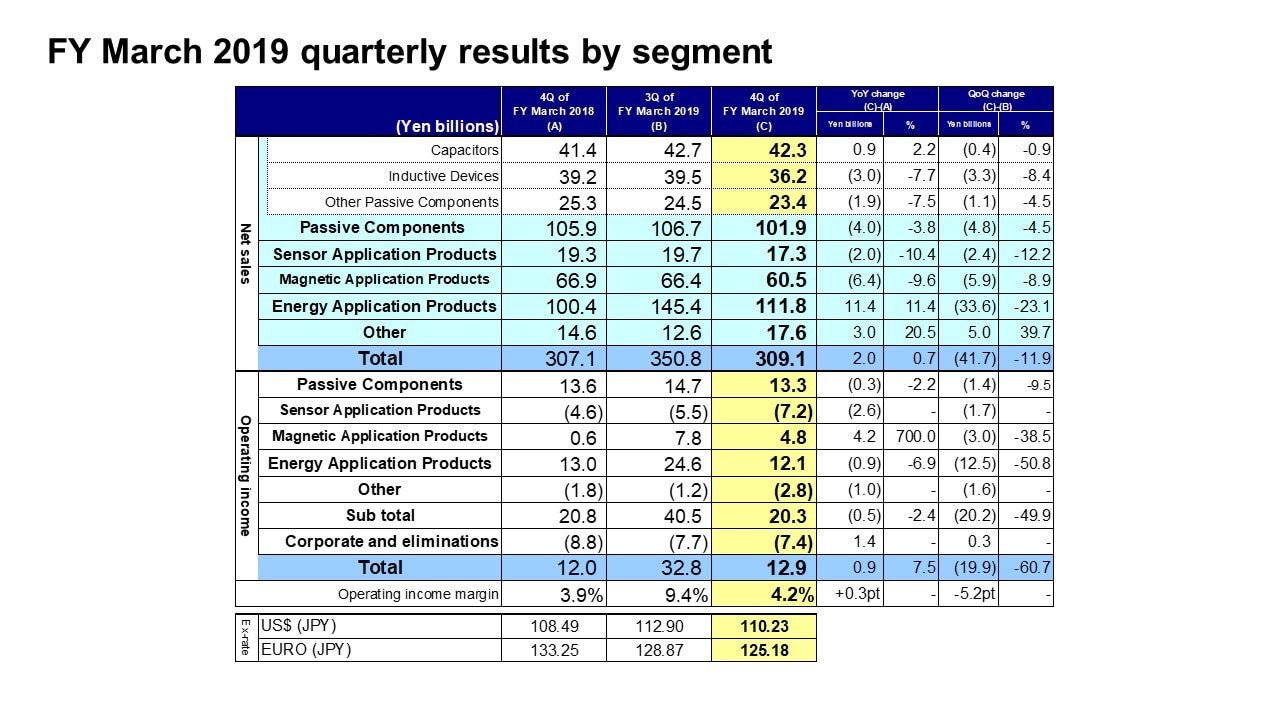[ Financial Results for Fiscal 2019 Performance Briefing ]Consolidated Results for FY March 2019
Mr. Tetsuji Yamanishi
Senior Vice President
Hello, I’m Tetsuji Yamanishi, Senior Vice President of TDK. Thank you for taking the time to attend TDK’s performance briefing for the fiscal year ended March 2019. I will be presenting an overview of our consolidated results.
Key points concerning earnings for FY March 2019
First, let’s take a look at the key points concerning earnings for the fiscal year ended March 2019. Net sales rose 8.7% year on year, and operating income increased 20.2%. Net sales achieved a new record for a sixth consecutive year. Operating income, income before income taxes, and net income attained new record highs. Operating income reached the 100.0 billion yen level.
From the middle of the third quarter, TDK saw a sharp slowdown in orders in its main market segments of automotive, ICT, and industrial equipment due to an economic slowdown in China set off by the trade friction between the U.S. and China. However, core businesses that had maintained a solid performance through the first half of the fiscal year continued to trend firmly in the second half, enabling year-on-year increases in sales and profits on a full-year basis.
In Rechargeable Batteries, sales were strong for mobile applications such as tablets and laptops, in addition to higher sales volume supported by a higher share of sales to major smartphone customers in China. Sales also increased for non-mobile applications such as mini cells. These factors led to large increases in sales and profits, thereby contributing immensely to growth in the Company’s overall earnings.
In Ceramic Capacitors, sales rose substantially centered on products with high reliability and redundancy characteristics for the automotive market. Profits expanded continuously, along with improved profitability, enabling Ceramic Capacitors to significantly lift the overall earnings base for the Passive Components segment.
In HDD Heads and HDD Suspension Assemblies, although shipments decreased following an approximate 10% year-on-year decline in aggregate demand for HDDs, the proportion of shipments of high-value-added products for data centers increased. Despite a year-on-year decline in sales, higher profits were secured, thereby supporting the overall earnings base.
Meanwhile, Sensors and Magnets, in addition to worsening market conditions, saw a delay in earnings improvements as new products were unable to be brought to market in a timely manner. Consequently, Sensors and Magnets had a negative impact on the Company’s overall earnings.
Consolidated full year results for FY March 2019
Moving along, I would like to present an overview of our results. Net sales were 1,381.8 billion yen, an increase of 110.1 billion yen, or 8.7%, year on year. Operating income was 107.8 billion yen, up 18.1 billion yen, or 20.2%. Income before income taxes was 115.6 billion yen, net income was 82.2 billion yen, and earnings per share was 651.02 yen. In accordance with changes in U.S. accounting standards related to retirement benefit cost, an approximate 4.1 billion yen portion of the net benefit cost included in operating expense in profit/loss in the previous fiscal year was reclassified to other deductions.
The average exchange rates for the fiscal year ended March 2019 were 110.94 yen against the U.S. dollar, mostly unchanged from the fiscal year ended March 2018, and 128.48 yen against the euro, an appreciation of 0.9%. In terms of the impact of these exchange rate movements, net sales decreased by around 5.0 billion yen while operating income increased by around 0.6 billion yen.
With regard to exchange rate sensitivity, as with our previous estimate, we estimate that a change of 1 yen against the U.S. dollar would have an impact of around 1.2 billion yen on full-year operating income, while a change against the euro would have an impact of around 0.2 billion yen.
FY March 2019 results - Passive Components segment
Next, I would like to explain our business segment performance.
From the fiscal year ended March 2019, we reclassified certain products and therefore we have regrouped results for the previous fiscal year. In the Passive Components segment, this change reduced net sales for the fiscal year ended March 2018 by 19.8 billion yen and increased operating income by 3.9 billion yen.
In the fiscal year ended March 2019, net sales were 433.4 billion yen, an increase of 3.7% year on year, and operating income was 58.4 billion yen, an increase of 16.3% year on year. The operating income margin was 13.5%, indicating improved profitability. In Ceramic Capacitors, sales increased atop strong sales of products with high reliability and redundancy characteristics for the automotive market. The earnings base for the Passive Components segment increased overall due to marked improvements in profitability driven by contributions from an improved product mix and productivity enhancements. In Aluminum Electrolytic Capacitors and Film Capacitors, profitability improved even as sales remained level with the previous fiscal year, mainly owing to higher sales to the industrial equipment and automotive markets, while there was a decline in sales for the renewable energy and home electric appliances markets in China. In Inductive Devices, sales increased atop firm growth in sales to the automotive market and increased sales to the smartphone market, despite a decline in demand for home electric appliances and game consoles in the Chinese market. Operating income decreased, mainly due to the impact of production adjustments in response to a slowdown in demand for industrial equipment and automobiles in the second half of the fiscal year. In High-Frequency Components, sales increased year on year atop increased sales of Ceramic Filters to the ICT market. Meanwhile, in Piezoelectric Material Products and Circuit Protection Components, sales and profit decreased year on year due to the impact of decreased sales to the ICT market and lower demand in the European automotive market, which was partly offset by higher sales to the industrial equipment market.
FY March 2019 results - Sensor Application Products segment
In the Sensor Application Products segment, the reclassification of certain products reduced net sales for the fiscal year ended March 2018 by 0.2 billion yen, while increasing operating income by 0.8 billion yen.
In the fiscal year ended March 2019, net sales were 76.5 billion yen, down 1.2% year on year, mostly unchanged from the previous fiscal year. There was a large operating loss of 22.1 billion yen, including around 5.4 billion yen in acquisition-related costs for InvenSense. Temperature and Pressure Sensors achieved higher sales on the back of increased sales of Pressure Sensors in the automotive market, despite the impact of a decline in demand for home electric appliances in China. Meanwhile, operating income decreased slightly, partly due to increases in development and sales promotion expenses for Pressure Sensor products. Magnetic Sensors achieved higher sales and profit owing to growth in sales of Hall sensors to the automotive market. TMR sensors recorded higher sales due to growth in sales for smartphones, and profits are improving. MEMS Sensors saw a larger operating loss, reflecting a sharp decline in sales due to the impact of the deceleration in the Chinese economy in the second half, in addition to delays in new product launches, with decreases in sales for use in smartphones and drones, and a decline in demand for use in game consoles. Other factors included cost burdens such as for development resources to accelerate commercialization of new models and initiatives to expand the customer base, which outweighed a 5.5 billion yen decrease in acquisition-related costs.
FY March 2019 results - Magnetic Application Products segment
In the Magnetic Application Products segment, the reclassification of businesses in connection with a reorganization reduced net sales and operating income for the fiscal year ended March 2018 by 55.7 billion yen and 4.8 billion yen, respectively.
For the fiscal year ended March 2019, net sales decreased 1.7% year on year to 272.8 billion yen, while operating income increased 5.6% to 17.0 billion yen.
Sales volume of HDD Heads decreased by around 8% year on year. However, a larger share of sales for nearline HDD Heads improved the product mix and raised the average sales price, lifting sales value. HDD Suspension Assemblies saw a lower sales volume, while sales value remained level due to an increase in the average sales price reflecting a larger share of sales for μDSA type. Overall sales of HDD Heads and HDD Suspension Assemblies remained level, reflecting higher sales of Suspension Application Products, which were mostly offset by lower sales due to a decreased sales volume of HDD assemblies. Operating income increased year on year, assisted by an increase in average sales prices and a positive contribution from improved earnings on Suspension Application Products.
In Magnets, sales decreased due to a decline in demand for applications such as wind power generators and industrial equipment. In the second quarter, an impairment loss of 4.7 billion yen was recorded mainly due to delays in improving productivity in the area of ferrite magnets. Consequently, the operating loss for Magnets as a whole increased.
FY March 2019 results - Energy Application Products segment
In the Energy Application Products segment, the reclassification of businesses in connection with a reorganization increased net sales and operating income for the fiscal year ended March 2018 by 71.9 billion yen and 2.0 billion yen, respectively.
In the fiscal year ended March 2019, net sales rose 21.4% year on year to 537.5 billion yen and operating income rose 25.7% to 91.0 billion yen.
In Rechargeable Batteries, sales in the Chinese smartphone market increased sharply on the back of a higher share of sales to major customers, while sales also increased steadily for mobile device applications such as laptops and tablets. Sales for non-mobile applications such as game consoles also rose. These factors lifted both sales and profits higher.
Power Supplies for industrial equipment saw sales and operating income remain mostly unchanged from the previous fiscal year, mainly due to the impact of a decline in demand for semiconductor manufacturing equipment and robots in the second half.
Breakdown of operating income changes
Next is the breakdown of the change in operating income. Let’s take a look at the main factors behind the increase of 18.1 billion yen in operating income. First, there was an increase in profits of approximately 39.4 billion yen due to an increase in net sales centered on Capacitors and Rechargeable Batteries, as well as an improvement in the product mix for HDD Heads and HDD Suspension Assemblies. Then there was a negative impact of around 19.1 billion yen due to a drop in sales prices. However, the impact was absorbed for the most part by a saving of about 21.5 billion yen due to rationalization and cost reduction, as well as the benefits of about 1.4 billion yen as a result of restructuring initiatives and an impairment loss of approximately 4.7 billion yen in Magnets. SG&A expenses increased by around 26.5 billion yen due to increases in administration and development expenses in connection with business expansion in Rechargeable Batteries, as well as higher costs arising from strengthening the development framework in the Sensor business and increased costs from newly acquired companies. Together with a decrease of around 5.5 billion yen in one-time M&A related expenses and an increase of around 0.6 billion yen from exchange rate fluctuations, the overall increase in operating income was 18.1 billion yen.
FY March 2019 quarterly results by segment
Next, I would like to explain the factors behind the changes in segment net sales and operating income from the third quarter to the fourth quarter of the fiscal year ended March 2019.
Let’s begin with net sales in the Passive Components segment. Net sales in this segment decreased by 4.8 billion yen, or 4.5%, from the third quarter. In Ceramic Capacitors, higher sales were derived from strong sales of products with high reliability and redundancy characteristics amid a slowdown in demand in the automotive market. On the other hand, sales of Aluminum Electrolytic Capacitors and Film Capacitors for use in automobiles and renewable energy in China declined. As a result, Ceramic Capacitor sales decreased by 0.4 billion yen, or 0.9%, from the third quarter. Sales of Inductive Devices decreased by 3.3 billion yen, or 8.4%, from the third quarter. Sales declined for the automotive market, smartphones, and industrial equipment due to the impact of the deceleration of the Chinese economy and declining demand in the European automotive market. In Other Passive Components, net sales declined by 1.1 billion yen, or 4.5%. In High-Frequency Components, sales of Ceramic Filters decreased, mainly for Chinese smartphones. Sales of Piezoelectric Material Products and Circuit Protection Components declined for the European automotive market. Operating income in the Passive Components segment decreased by 1.4 billion yen, or 9.5%, from the third quarter. The main factors were lower sales and profits from Inductors and High-Frequency Components, although a solid performance was maintained in Ceramic Capacitors with growth in sales and profits.
In the Sensor Application Products segment, net sales fell by 2.4 billion yen, or 12.2%, from the third quarter. Sales of Temperature and Pressure Sensors were almost level from the third quarter, while sales of Magnetic Sensors for the European automotive market, as well as for smartphones, decreased sharply. Sales of MEMS Sensors declined for smartphones, as well as for drones and game consoles. Operating income remained mostly level for Temperature and Pressure Sensors, as with sales of these products, but operating income declined for Magnetic Sensors due to lower sales. In MEMS Sensors, the operating loss expanded due to the impact of lower sales, despite a decline in acquisition-related costs for InvenSense of 0.6 billion yen from 1.6 billion yen in the third quarter to 1.0 billion yen in the fourth quarter. The overall operating loss for the Sensor Application Products segment increased by 1.7 billion yen.
In the Magnetic Application Products segment, net sales decreased by 5.9 billion yen, or 8.9%, from the third quarter. The main reasons were a decrease of around 6% in the HDD Heads shipment index from 81 in the third quarter to 76, and a decline in the sales volume of HDD Suspension Assemblies. Sales of Magnets decreased, reflecting a drop in demand for industrial equipment. Operating income in the Magnetic Application Products segment decreased by 3.0 billion yen from the third quarter. The main reasons were a decline in sales volumes of HDD Heads and HDD Suspension Assemblies, and a loss on reduction in capacity utilization due to the Chinese Lunar New Year holidays in the fourth quarter.
In the Energy Application Products segment, net sales decreased by 33.6 billion yen, or 23.1%, from the third quarter. In Rechargeable Batteries, sales decreased due to a decline in sales for mobile device applications such as smartphones due to the deceleration of the Chinese economy, and a decrease in sales for game consoles, in addition to a decline in sales due to seasonal factors. Sales of Power Supplies for industrial equipment decreased due to a drop in demand for industrial equipment. Operating income was 12.1 billion yen, a decrease of 12.5 billion yen from 24.6 billion yen in the third quarter. This decrease reflected several factors. In Rechargeable Batteries, profit was affected by a decrease in marginal profit due to a drop in sales volume, as well as the impact of a time lag between reflecting the lower market price for cobalt materials in our sales prices and experiencing the effect of the lower market prices as the market prices of cobalt materials declined further from the third quarter. Moreover, profits declined sharply due to a loss on reduction in capacity utilization due to the Chinese Lunar New Year holidays in the fourth quarter. Another factor was lower sales of Power Supplies for industrial equipment.
That concludes my presentation. Thank you very much for your attention.

